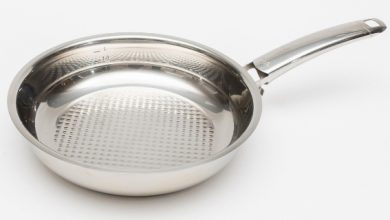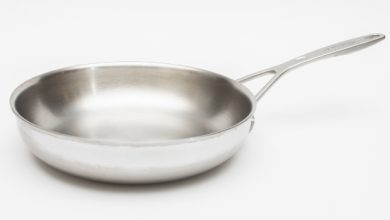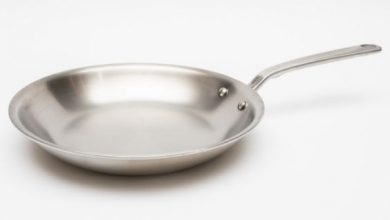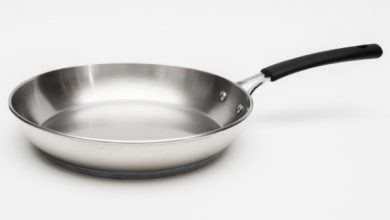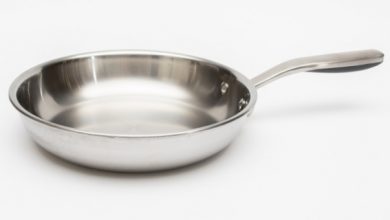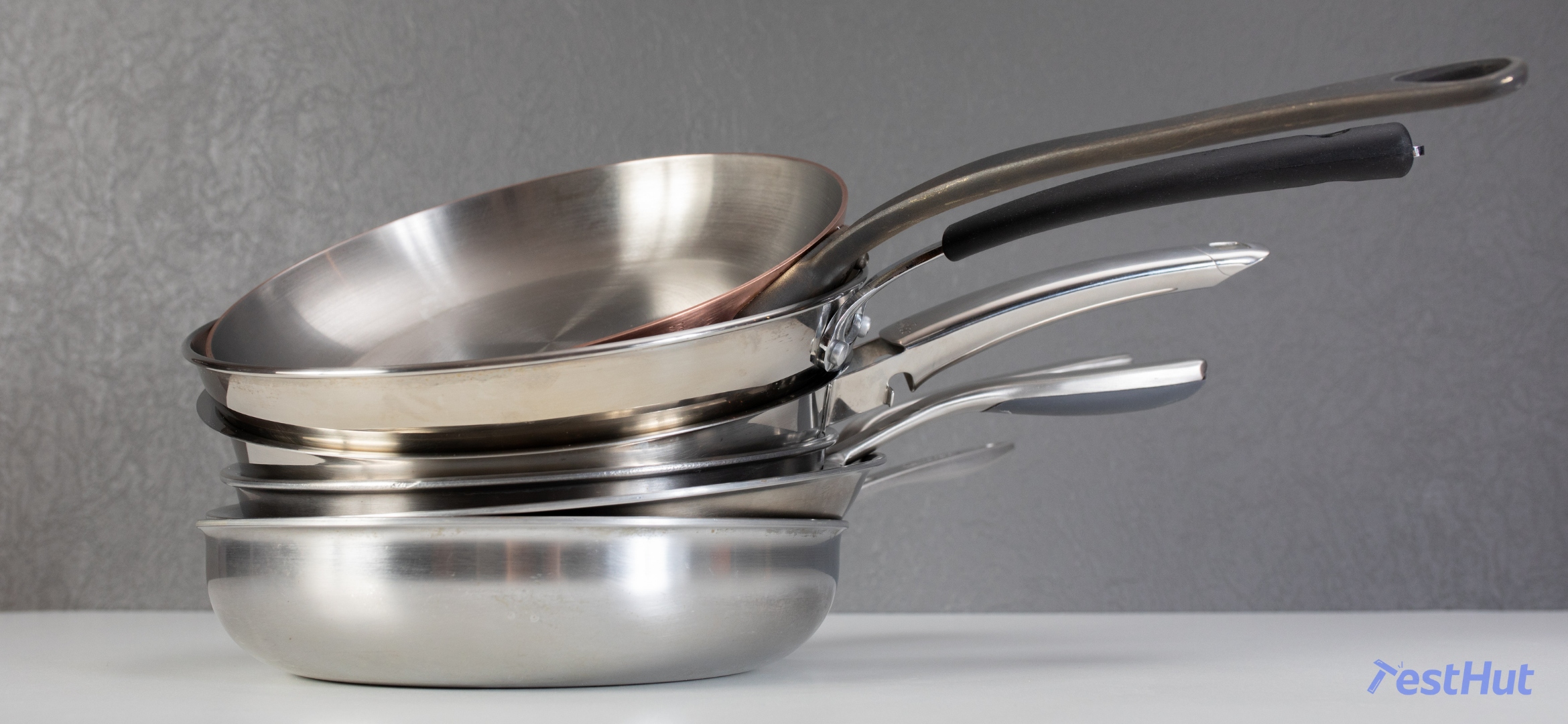
The Best Stainless Steel Pan
Stainless steel pans have been a staple in kitchens for a long time. These warriors of the stove top are versatile and iconic, but not all steel is made the same. We wanted to find the best stainless steel pan, so we put them through our rigorous testing process to bring you our verdict.
TestHut’s Top Choice: Fissler Crispy Steelux 24 cm
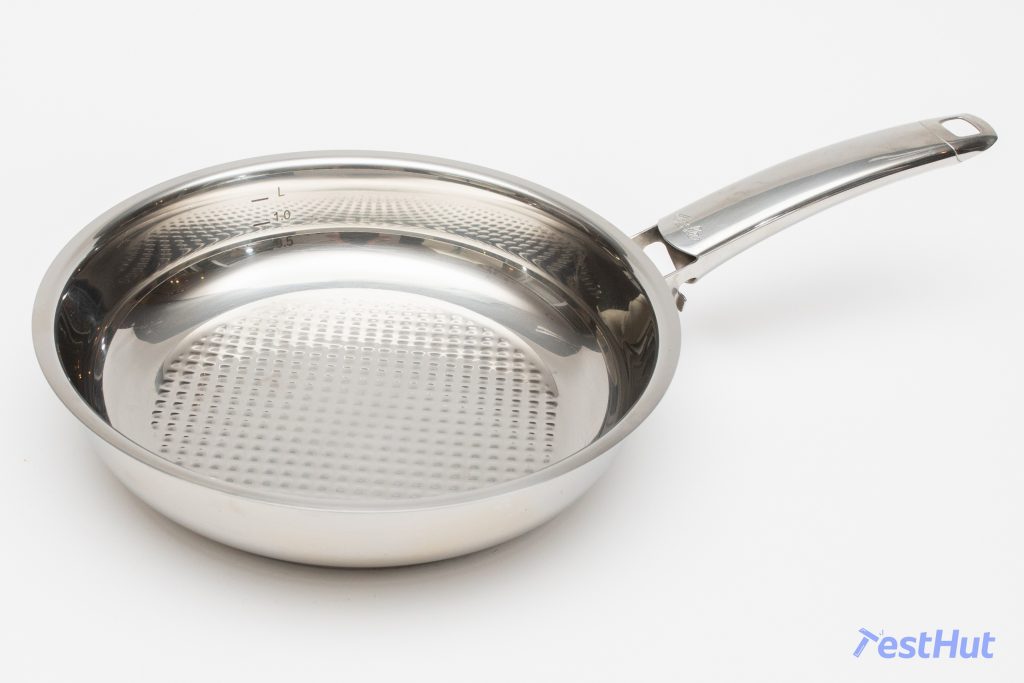
Fissler Crispy Steelux Features & Specs
- Size: 24 cm
- Weight: 1.1 kg
- Material: Stainless Steel
- Coating: None
- Handle: Steel with no rivets
- Dishwasher safe: Yes (not recommended)
- Metal utensils: Yes
- Oven Safe: 230°C
- Hobs: All (gas, electric, ceramic, induction)
Our top choice came as no surprise to us. After our home tests, we all agreed that the Fissler Crispy Steelux pan was the easiest pan to cook with and the one that gave us great results time and time again.
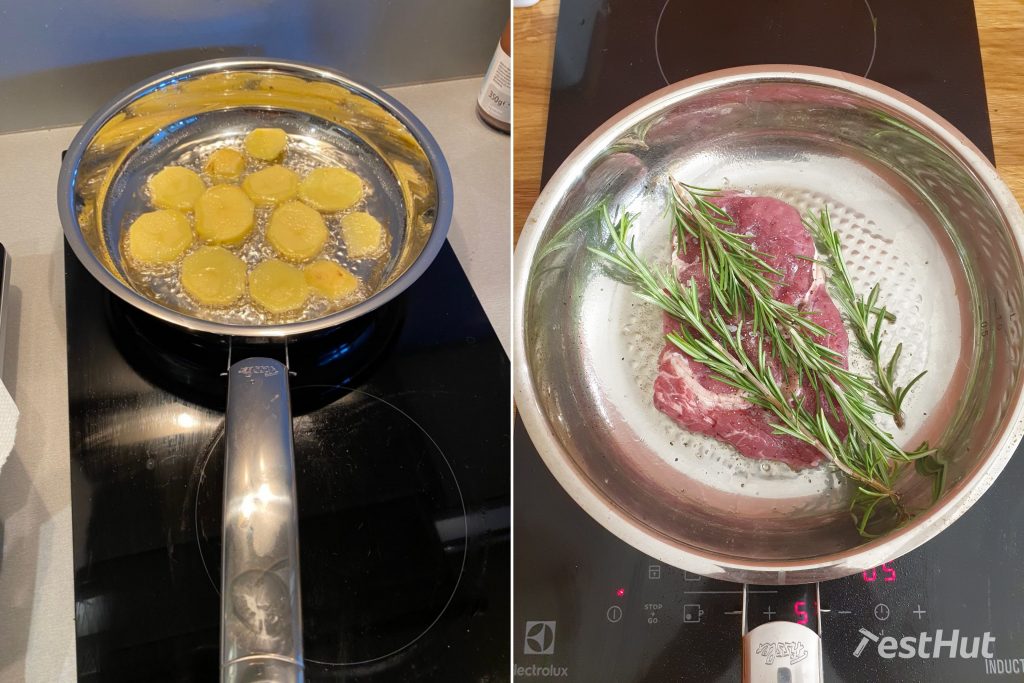
The most impressive feature of this pan was its incredibly even heating. It is a disc pan, so there is a disc bonded to the bottom that Fissler calls its “cookstar all-stove base”, which means it works with any hob including induction. And we found that in both the flour test and long-term chicken breast fry, this pan had even temperatures across the entire surface varying just 4 degrees when tested at 5 different points on the pan.
It is also a very versatile pan with a nice shape that can hold lots of food, 2.2 litres or up to 5 chicken legs at once. The inside of the pan has an integrated measuring scale, so you can see how much liquid is in the pan. The rounded corners make stirring and spatula access quite easy. The pan is rugged, and we like that there are no rivets inside that get in the way while cooking and cleaning. It has a very thin pouring lip all around that made pouring clean and easy.
The handle was not the most comfortable in our tests, but it fits in the hand nicely and gives good control of the pan. It is very well balanced and easy to manoeuvre. It is also safe reaching just 28°C where you grip it.
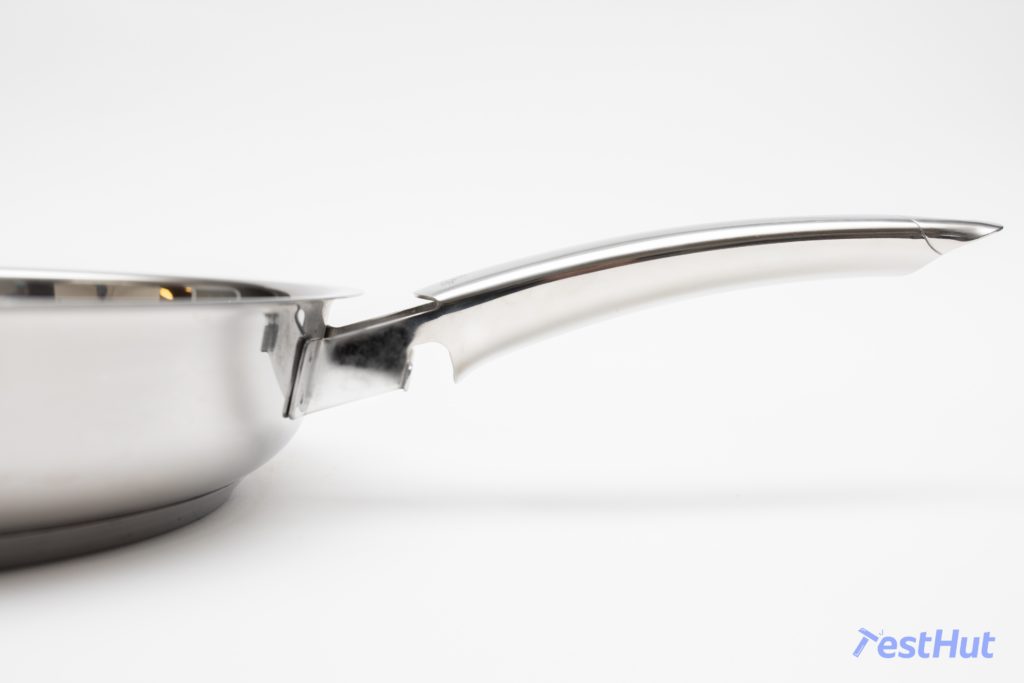
We were also impressed with the food release in the Fissler. As we learned to cook with stainless steel so foods would not stick like glue, this pan never gave us trouble and this made it easy to cook with. The corrugated Novogrill surface seems to keep foods from sticking. In our final omelette test, there was no residue left behind in the Fissler at all. Other stainless pans were challenged by bacon and eggs, but with just a little butter or oil, the Fissler pan released like a champ. Novice chefs will appreciate this feature.
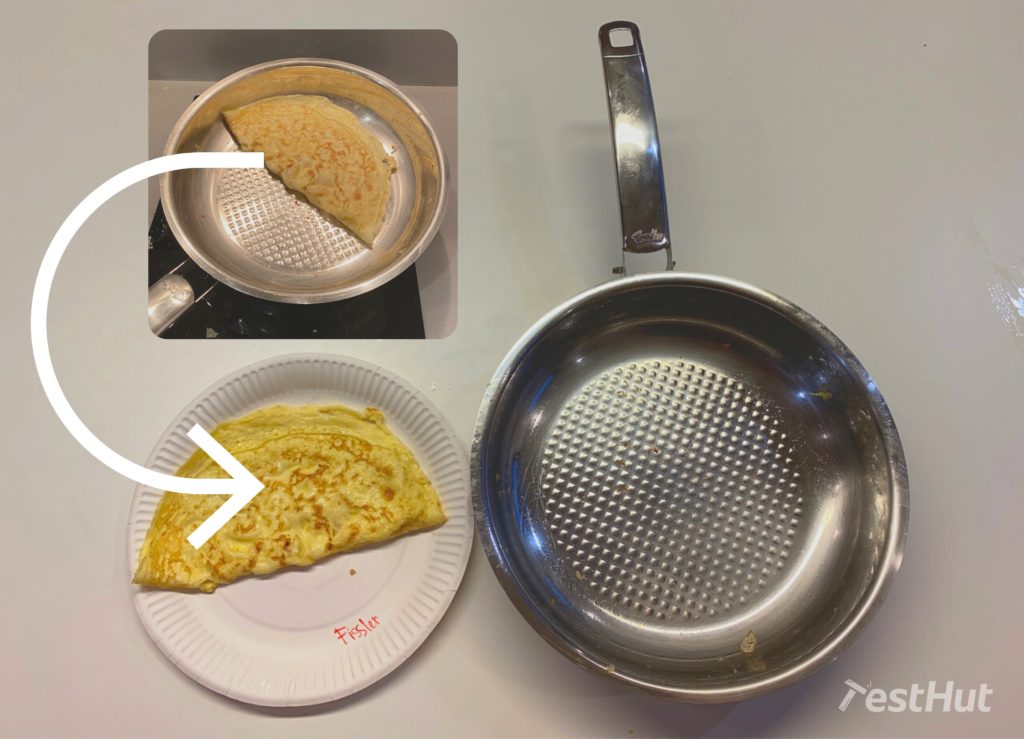
The pan is not the best looking stainless. The handle has all kinds of nooks and crannies that need to be cleaned. We found out later that it is designed to hold special lids in place, which is cool. The disc is noticeable and the outside and inside sides of the pan stain over time, so you either have to be okay with the pan forming a patina or plan to scrub vigorously to keep it shiny.
One thing to watch out for is that the disc is so efficient, that the pan will get hot if left on the same heat setting for too long. It really works best on medium-low heat, and we did find that it overheated on induction.
What we didn’t like
We wish that the Fissler heated a bit more stably, especially on induction. The increase in temperature over time was just a bit too extreme for our liking reaching over 250°C on medium-high heat setting after a few minutes. On induction it got even hotter, reaching 290°C after 10 minutes.
In addition, the opening in the handle and all the nooks and crannies made keeping the exterior of this pan clean a bit of a challenge.
Conclusion
The Fissler proved to be our favourite and highest scoring stainless pan, and we think that anyone will find it easy to use and a great cooking companion in your kitchen. If you are ready to enter the world of stainless steel, you can’t go wrong with this pan.
Premium Choice: Demeyere Industry 24 cm
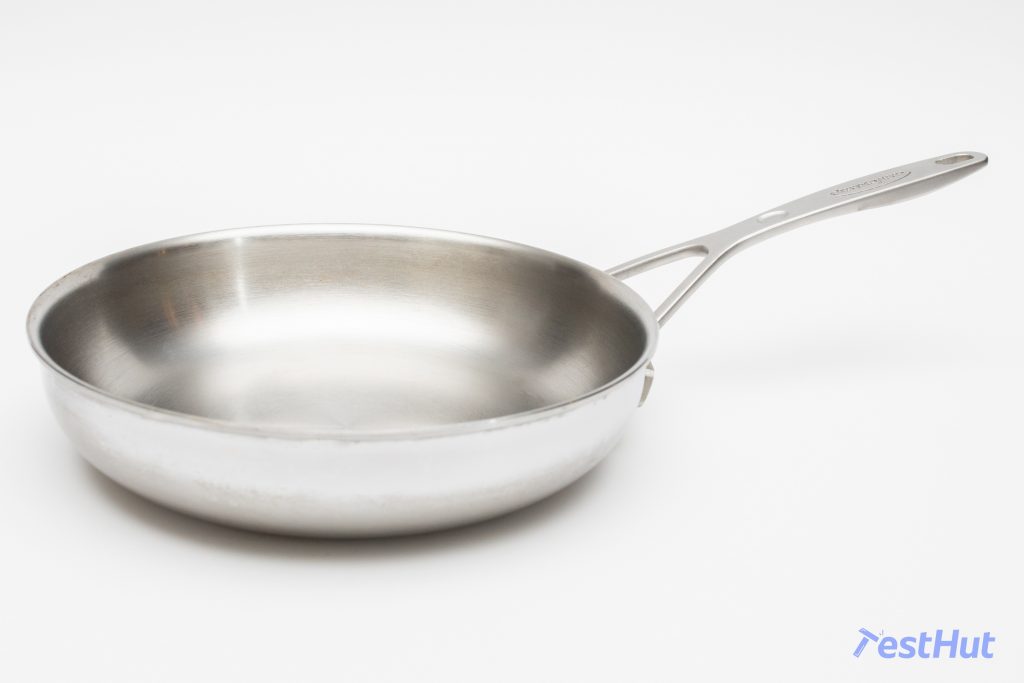
Demeyere Industry Features & Specs
- Size: 24 cm
- Weight: 1.2 kg
- Material: Stainless Steel
- Coating: None
- Handle: Steel with no rivets
- Dishwasher safe: Yes (not recommended)
- Metal utensils: Yes
- Oven Safe: 350°C
- Hobs: All (gas, electric, ceramic, induction)
The Demeyere is a striking pan with a matte steel finish and a long metal handle. It is a clad pan which means that there is no disc. It has 5 layers of steel and aluminium to make it a high-performance sports car of a frying pan.
This pan got the highest marks for versatility. It is shaped more like a sauté pan than a true frying pan which allows you to cook not only fried foods like savory steaks and perfectly grilled salmon, but also braised beef and it was the best pan for making sauces. It has a large capacity of 2.3 litres. We also loved flipping food effortlessly with this pan. A flick of the wrist was all it took to turn over crepes and omelettes with ease.
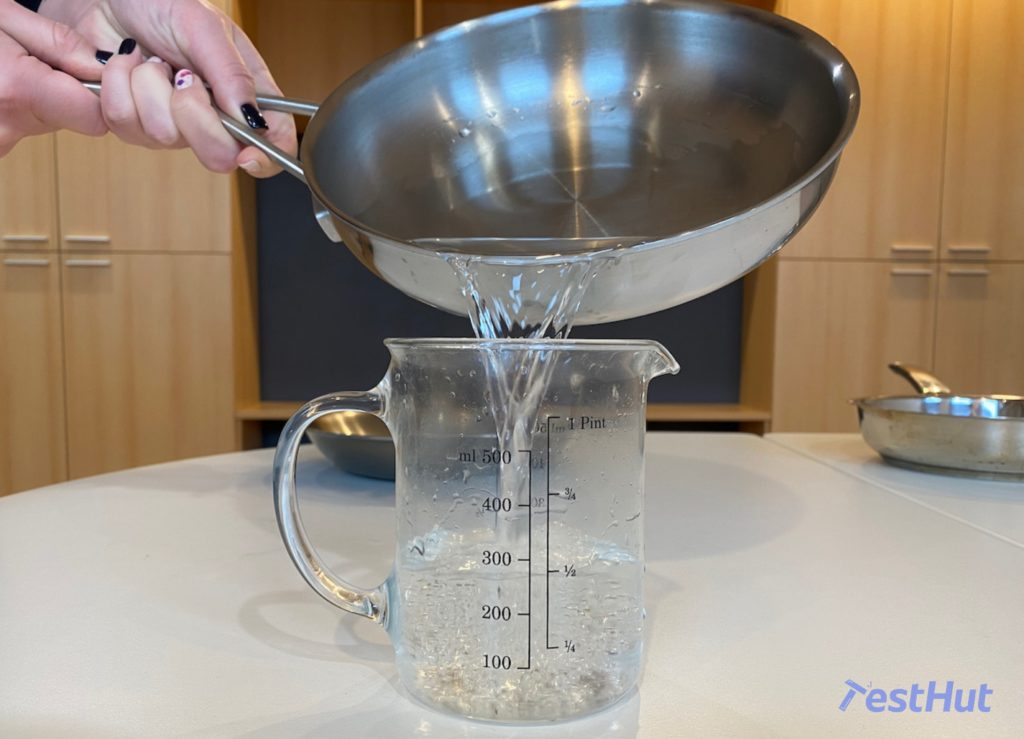
The pan also got high marks for design. We love the clean lines and long, rivetless handle. It has gone through a special Silvinox treatment which gives it a matte finish that will stay shiny and clean up easily. We found that the Demeyere did clean up very well, and even after months of cooking, there is not much of a patina inside or outside.
The pan heats up super fast, taking under a minute to reach 200°C on our electric hob. This took some getting used to because if you are not careful, it can scorch your food. Once we learned how to cook with the pan, we were able to produce virtually perfect eggs and pancakes. The release was just about as good as the Fissler.
The handle is long and it stayed relatively cool in our tests reaching just 27°C, but it is a bit narrow, and the pan can spin in your hand if you don’t have a tight grip.
The rounded corners and high sides of the pan make it easy to use and stirring in this pan is a delight.
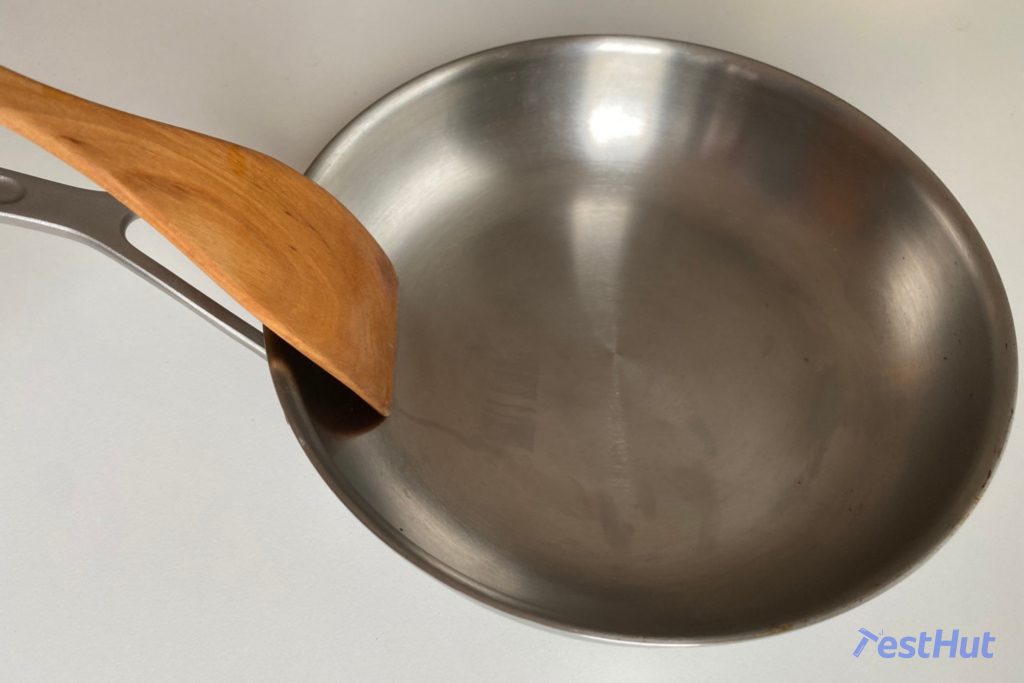
We found that in our evenness test this pan heats up in the centre very quickly, but after 5 minutes the temperature evened out with an 11 degree variance across the surface. So some of our cooking results were not as flawless as they were with the Fissler. There is a bit of a learning curve with a professional pan, but once you get the hang of it, the Demeyere will give wonderful results and last for a long, long time.
What we didn’t like
Foods stuck to the surface of the Demeyere a bit more than we would have liked during our tests.
In addition, the heating is so fast and erratic that it took some time to get used to. But we think this is a feature and not a bug.
Conclusion
If you are ready to step up to professional stainless steel, then we think you cannot go wrong with the Demeyere Industry series. These pans are beautiful, durable and have incredible heating properties.
Budget Choice: Lagostina Tempra 26 cm
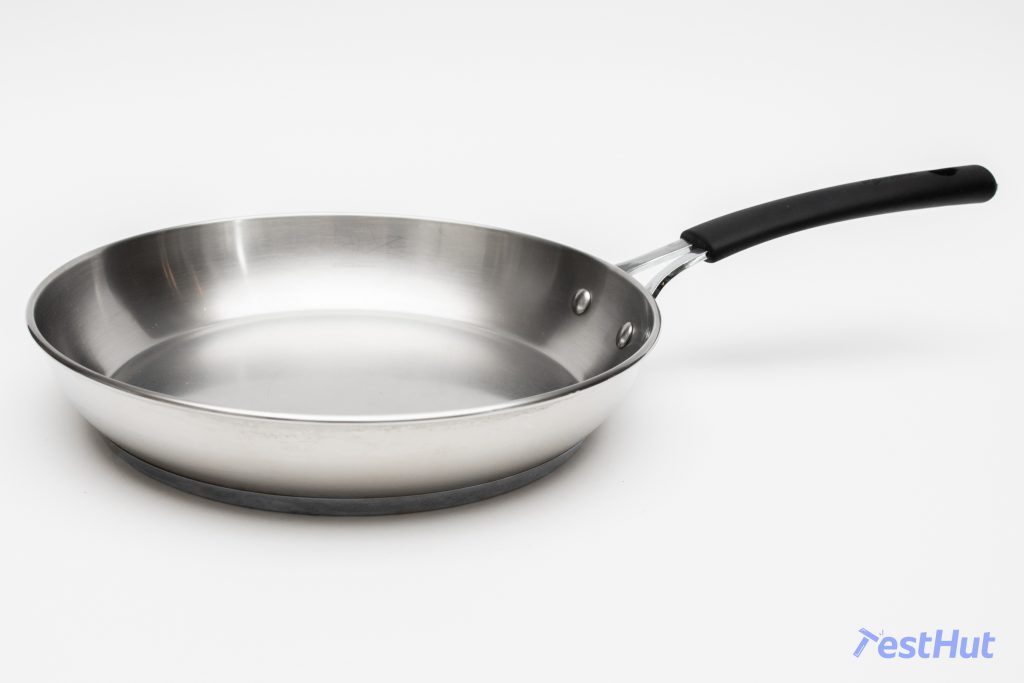
Lagostina Tempra Features & Specs
- Size: 26 cm
- Weight: 1.4 kg
- Material: Disc Stainless Steel
- Coating: None
- Handle: Steel with silicone cover
- Dishwasher safe: Yes (but not recommended)
- Metal utensils: Yes
- Oven Safe: Yes (210°C)
- Hobs: Gas, electric, ceramic, induction
If you want to dip your toes into the world of stainless, but you are not ready to invest too much, then the Lagostina Tempra pan is a good place to start.
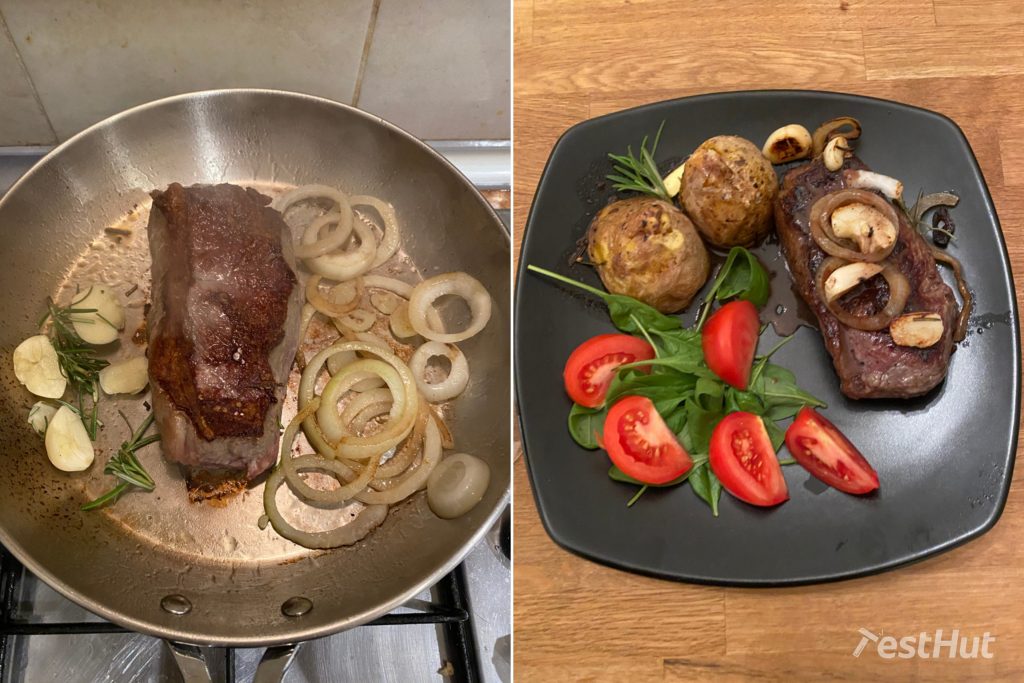
At first, we were not impressed by the Lagostina with its industrial steel and heavy disc. The handle is coated with silicone, so it doesn’t have the natural beauty of some other pans. But we couldn’t judge this book by its cover.
We became impressed with this pan after our first evenness test when we saw the flour brown perfectly across the entire surface of this large pan and it was just as even as the Fissler over time with just a 4°C difference across the pan. It also held its own in the food release tests and we were able to get mostly good results in our cooking tests. It was a bit stickier than the Fissler pan, but again, once we got used to working with stainless, the results were more and more consistent.
This is a big pan and it can hold a lot of food holding 2.2 litres and up to 6 chicken legs at one time. It is versatile, but it does have sharp corners which make it a little harder to use with a spatula and other utensils. It does not have a pouring lip, so things got a little sloppy when we tried to pour a tomato sauce out of the pan. Flipping food was a bit more challenging with this large pan because the high, straight sides did not allow food to escape as easily.
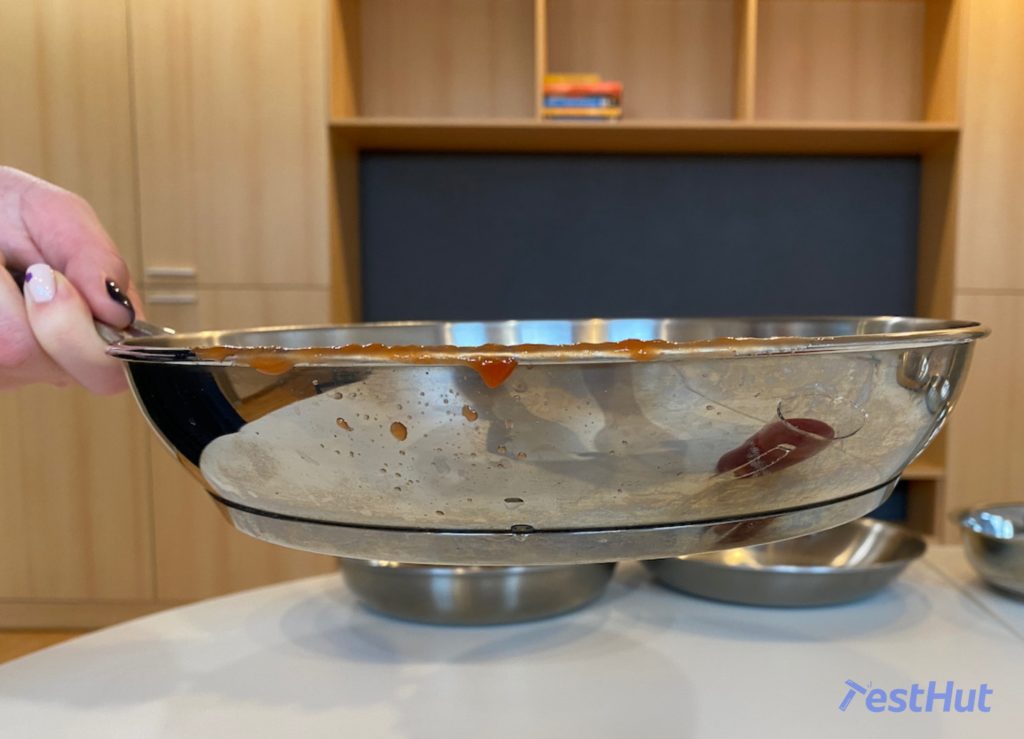
The handle is comfortable and it stays cool at just 28°C, but the silicone grip does limit the temperature for oven use to 230°C, and we can see the grip wearing out over time.
It was a bit heavier than the other pans in our test at about 1.4 kilograms, and it took a little longer to get warm, taking over 2 minutes to 200°C.
The pan cleans up well because it doesn’t have any uneven surfaces. There are rivets inside, but these did not cause too many problems with cooking or clean-up.
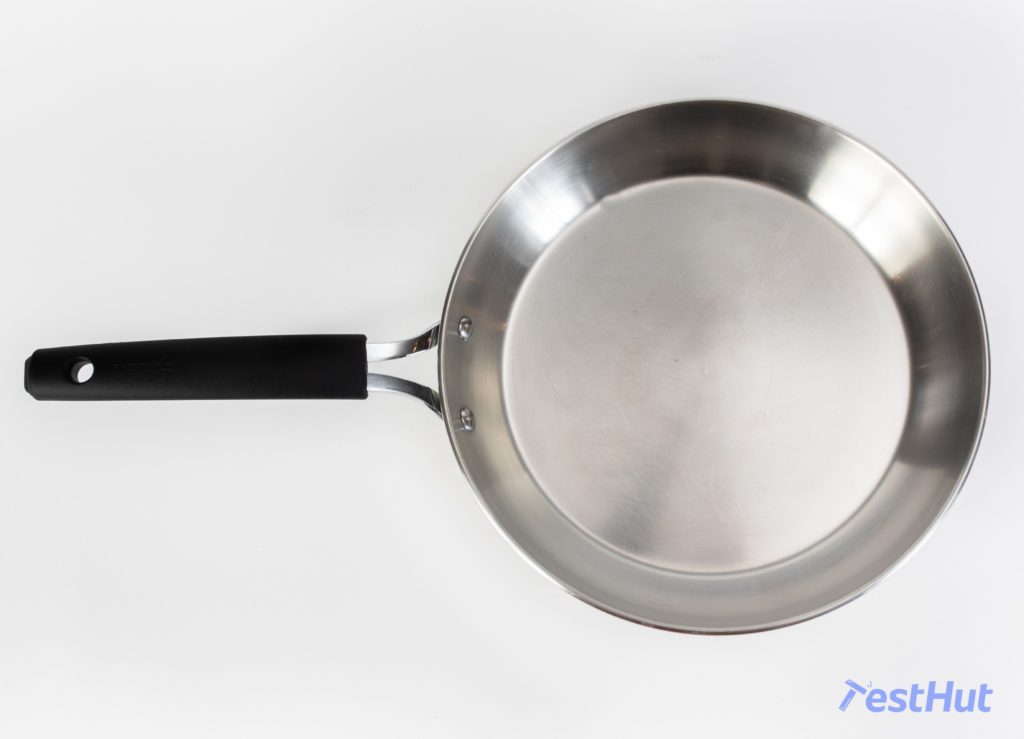
At 26 centimetres, this pan is larger than others we tested, so it will take more room to store, and it is not as aesthetically appealing as the Demeyere or Fissler.
What we didn’t like
The industrial design and dullness of this pan were a bit of a put off. It also just felt bigger and less well-balanced than the other pans in our test.
The surface also was just a little stickier than the Fissler pan.
Conclusion
We think that the Lagostina Tempra stainless steel pan is a quality product that will meet most of your cooking challenges at a very nice starting price point.
Also good pans
Although these pans were not winners, there is nothing wrong with them. You may find that they offer features or options that the Fissler or Demeyere do not. These are worth taking a look at.
Made In stainless clad frying pan 10”
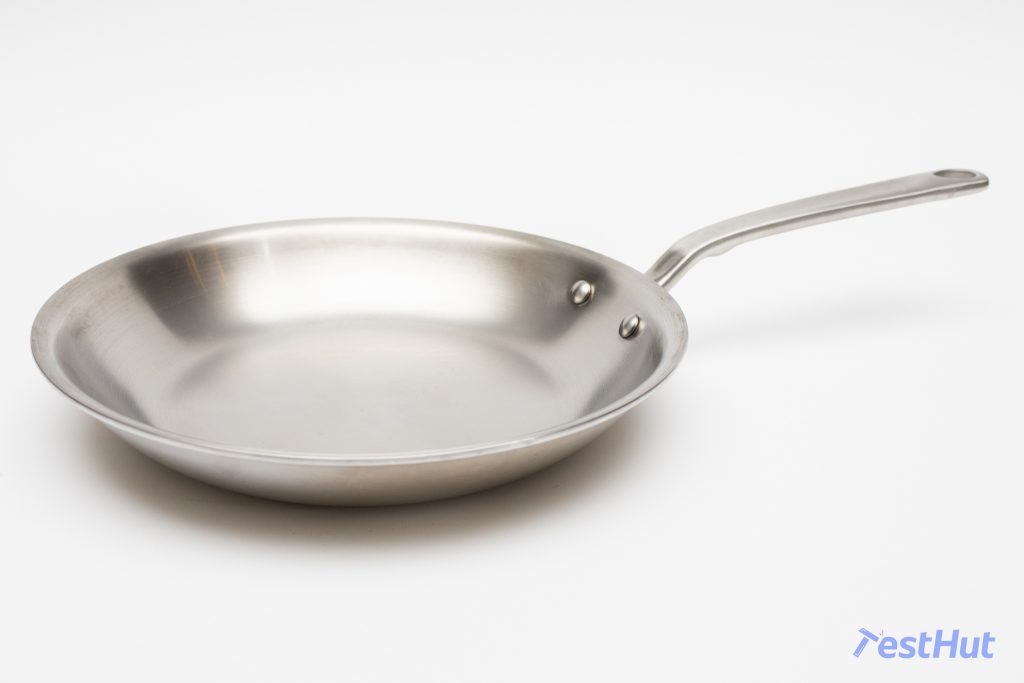
Made In Features & Specs
- Size: 26 cm (10 inch)
- Weight: 1.2 kg
- Material: Clad Stainless Steel
- Coating: None
- Handle: Steel with rivets
- Dishwasher safe: Yes (not recommended)
- Metal utensils: Yes
- Oven Safe: Yes
- Hobs: Gas, electric, ceramic, induction
The Made In frying pan came to us all the way from America in a lovely red and white box with a little attachment of rosemary seeds. We thought this was a nice touch.
This pan got our highest marks for aesthetics out of all the stainless pans. As a fully clad pan, it has clean lines and a nice low profile with a long handle. It looks built to perform on a stove.
The Made In pan heated the fastest of all taking less than 30 seconds to reach 200°C. Like the Demeyere, this took a bit of a learning curve to get used to.
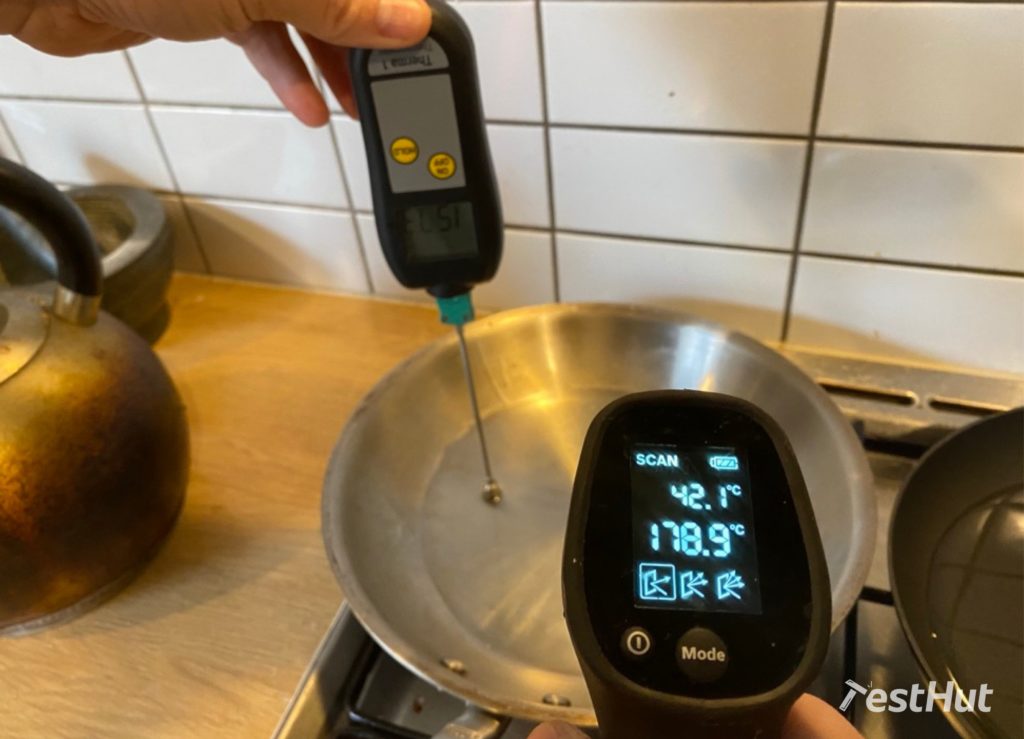
This pan lost marks when it came to release because we found that more foods stuck to the surface than in the Fissler. It also did not heat as evenly as some other pans with a 12 degree variation in our tests, but in most of our cooking tests, foods turned out very well.
We like the shape of the pan with its low flared sides. These proved to be perfect for high-heat searing and for flipping foods. No pan flipped as well as the Made In. However, the shape was not as versatile as others in our test. For example, you can’t make a big stir-fry in this pan as it only holds 1.5 litres and will only fit 4 chicken legs at one time.
[videopack id=”1554″]https://www.testhut.com/uk/wp-content/uploads/sites/9/2021/08/MadeIn_flip-1.mp4[/videopack]One testing note is that the first pan in our test warped over time. Made In honoured the warranty and sent us a brand new pan at no cost. The second pan survived all our tests and showed no signs of warping or other deformities.
All in all, we liked the Made In pan, but we think you can get a more versatile pan at this price point.
Ikea Sensuell 24 cm
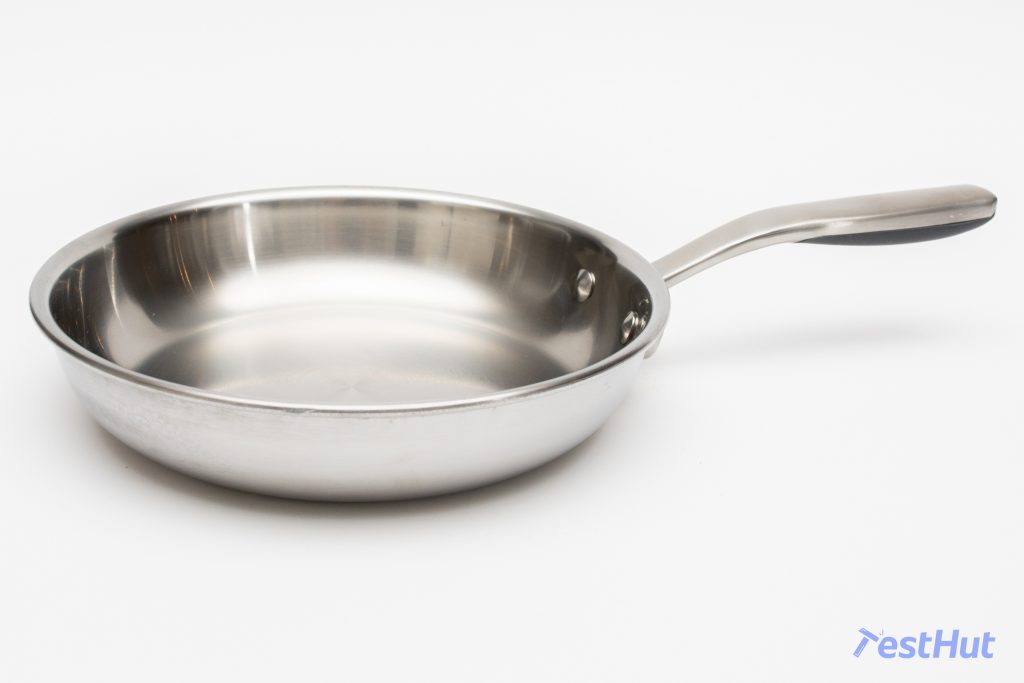
Ikea Sensuell Features & Specs
- Size: 24 cm
- Weight: 1.3 kg
- Material: Clad Stainless Steel
- Coating: None
- Handle: Steel with silicone padding and rivets
- Dishwasher safe: Yes (but not recommended)
- Metal utensils: Yes
- Oven Safe: Yes (but no temperature rating)
- Hobs: Gas, electric, ceramic, induction
The Ikea Sensuell pan was the lowest cost pan in our test, and it also earned the lowest overall score. We initially liked the compact shape of the pan, but in our tests, it did not do as well as the other pans.
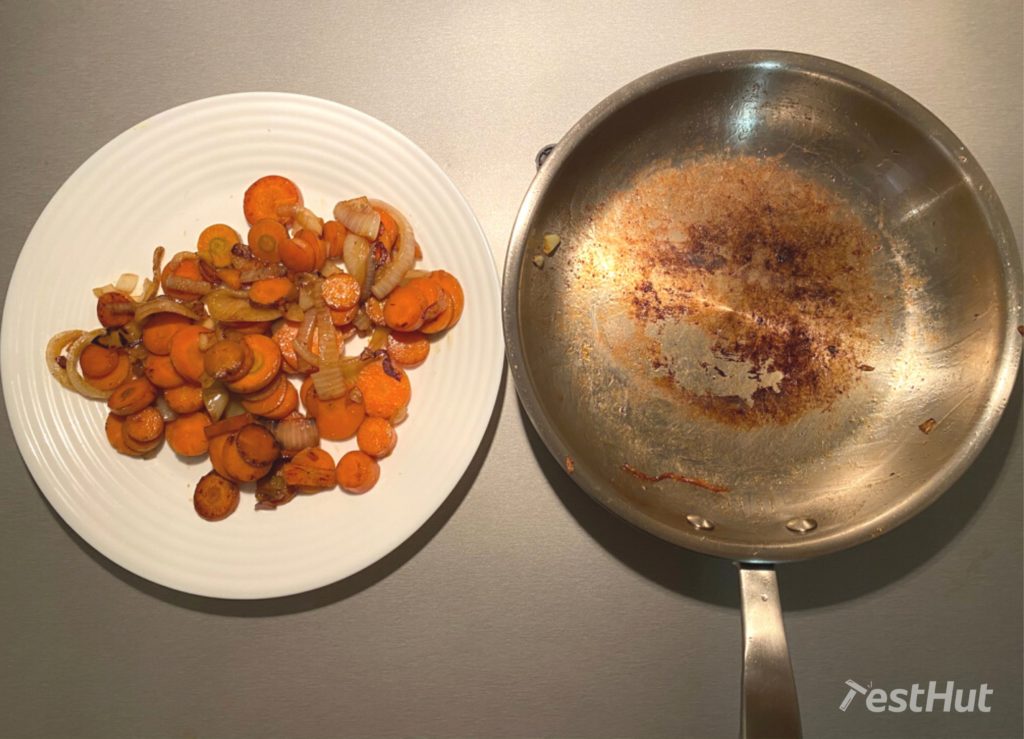
Even though the pan is small, capable of fitting just 4 chicken legs at one time, we found it to be pretty versatile and it comes in at a great price point for a clad pan. It was a good pan for flipping, and it is great for sauce preparation. It also heated quickly taking less than a minute to reach 200°C.
With rounded corners and a decent pouring lip, both utensil use and pouring were easy, and although it looks compact, it does hold 1.7 litres.
Food release was a bit of a struggle with this pan, and we had some problems with even cooking during our tests. Results in the long-term frying test showed just a 7 degree difference across the surface of the pan, but in actual cooking tests we still had problems with foods cooking evenly.
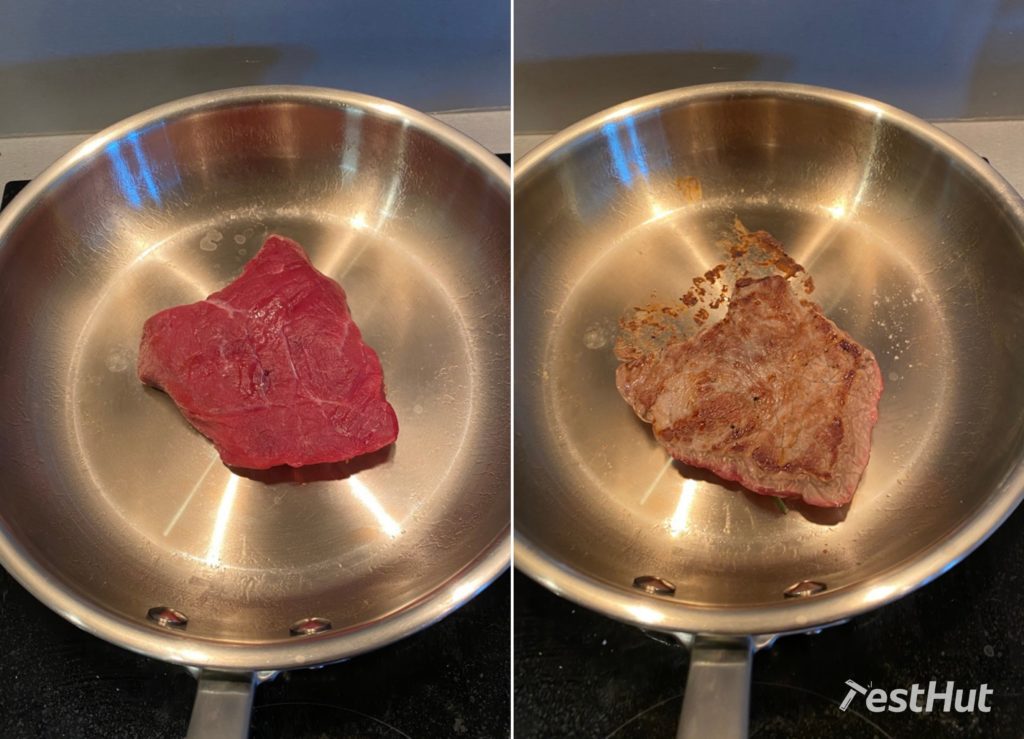
The handle is short with a silicone pad on the underside. This made the pan feel a bit unbalanced, and we noticed that the pad was separating from the pan after our tests. We would much better prefer a pan with no padding because this will wear out. It stayed mostly cool, but because the handle is short, you have to be careful not to grip too close to the body of the pan. It reached 35°C at the thumb rest, and if you accidently touch the base of the handle, it will burn you. It was 68°C.
We also saw this pan reaching very high temperatures in our long-term cooking test, rising above 250°C which was the highest in our electric hob tests.
We think that Ikea is moving in the right direction with their Sensuell pan line. We love the idea of an affordable all-clad pan with a nice design, but they can improve the cooking quality to make this a more worthwhile purchase.
Stainless frying pan research
When we set out to find the best stainless pan, we started by reading all about stainless steel pans and the features that separated one from another. We learned about the technology behind the pans and saw which manufacturers were continually producing quality products.
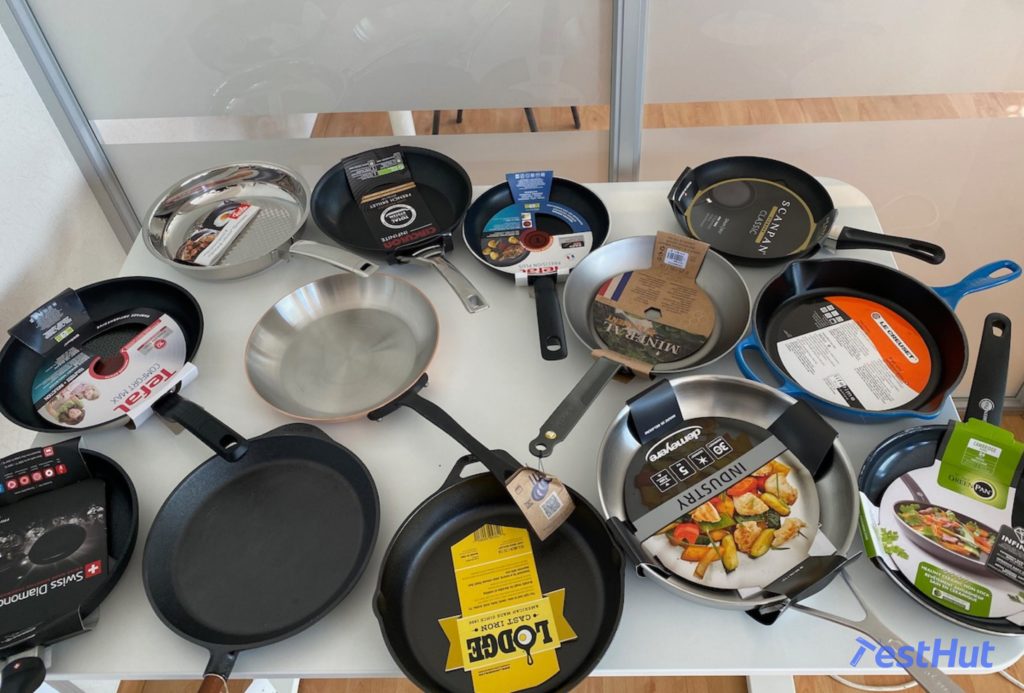
We checked to see which pans professional chefs were using and recommending along with professional and amateur reviews of pans all over the world.
In the end, we wanted to compare industry standard pans like Demeyere to the relative newcomer from America, Made In. We saw the German Fissler pan winning tests, and read about how long these pans last with their long history of quality products. After researching, we needed to see the difference between disc versus clad pans. We also wanted to see how more budget-friendly pans would compare, so we got an Italian Lagostina and IKEAs Sensuell pan to round out the test.
How we tested
The most important feature of any pan is that it can cook your food flawlessly. Our testing panel of 3 chefs with various levels of experience tried out these pans on gas, electric and induction hobs, cooking with these stainless pans over and over again to see what kind of results they could give us.
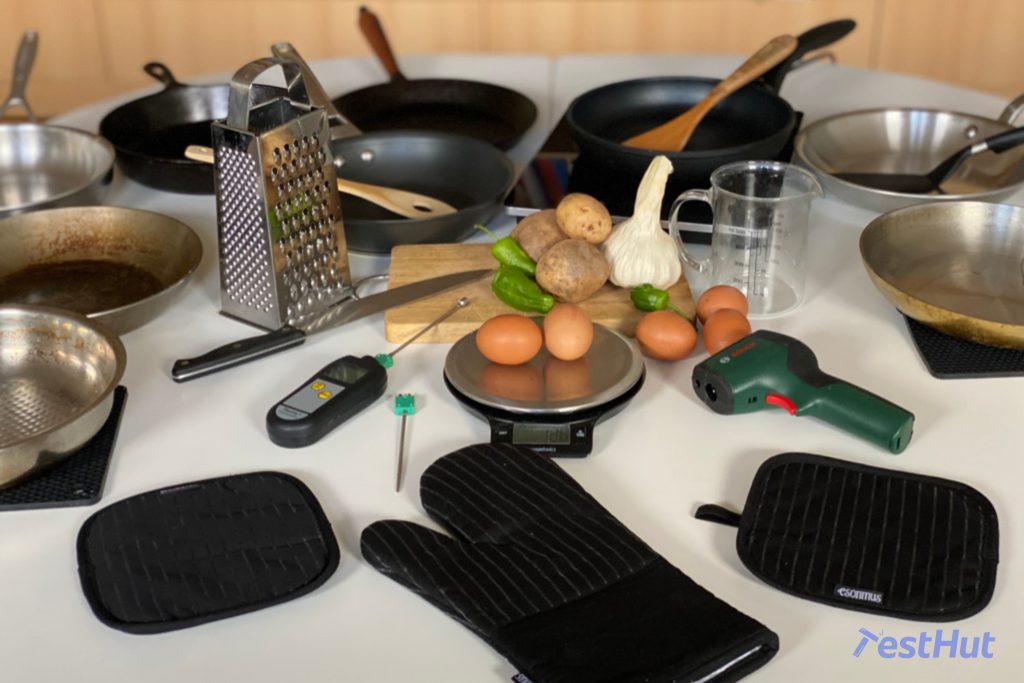
Stainless pans are not nonstick, but some did release food better than others. To test this, we cooked various sticky foods using different hobs and taking lots of suggestions from chefs and online sources about how to make these pans as nonstick as possible. Eggs were always a bit of a challenge, but with patience, the right heat, and some oil, they turned out fine in most of our test pans.
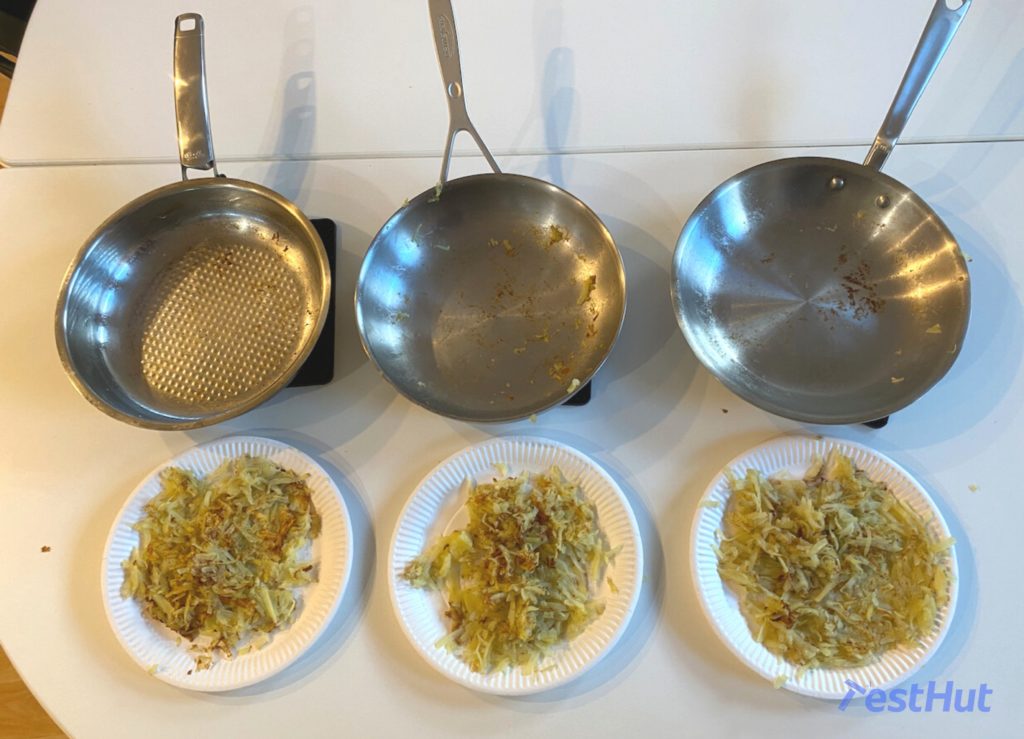
We also tested the heating properties, evenness and steadiness to see how these pans compared. Using a professional thermometer, we heated these pans to 200°C to see how long it would take. We tested 5 points on the surface of the pan while cooking to see how evenly they heated. During a long-term cooking test, we tested the temperature to see how steady the pans were over the same heat setting.
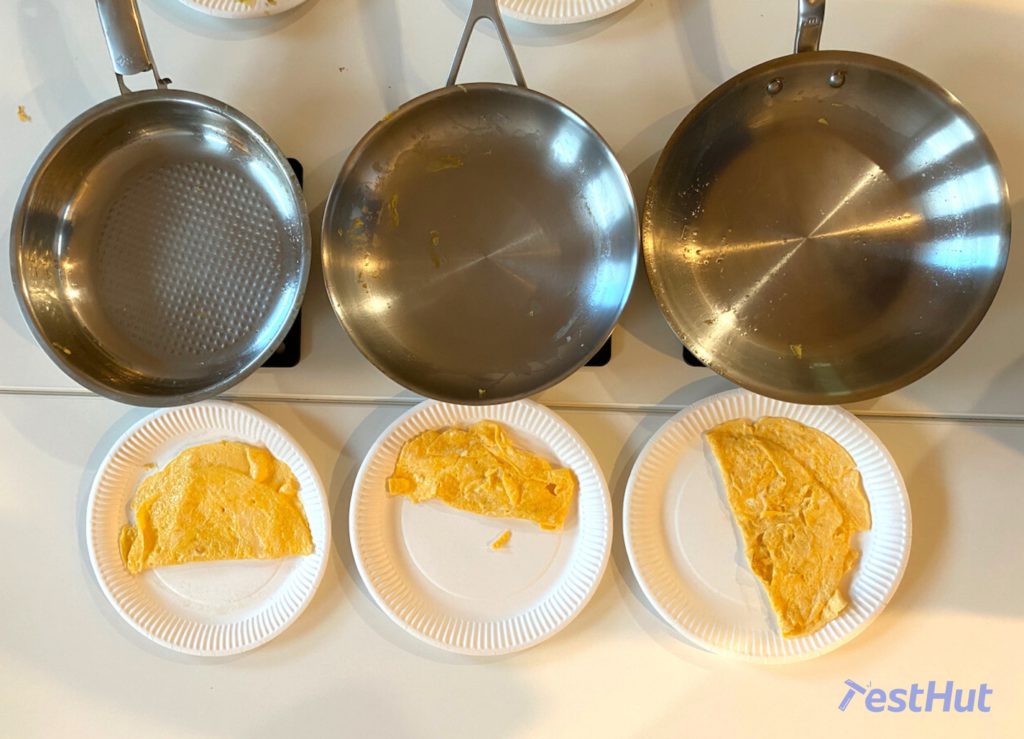
Stainless pans are virtually indestructible, but we still put them through our durability tests, heating them over high heat and then drenching them in cold water, scratching and scraping them, and checking for overall toughness after all of our tests.
To test ease of use, we compared handles noting the relative balance and comfort of each pan. We tested the temperature of the handles at various grip points to check for safety. We also noted the pan’s temperature climb and control on various hobs. Finally, we tested each pan to see how easy they were to access with utensils like spatulas and whisks.
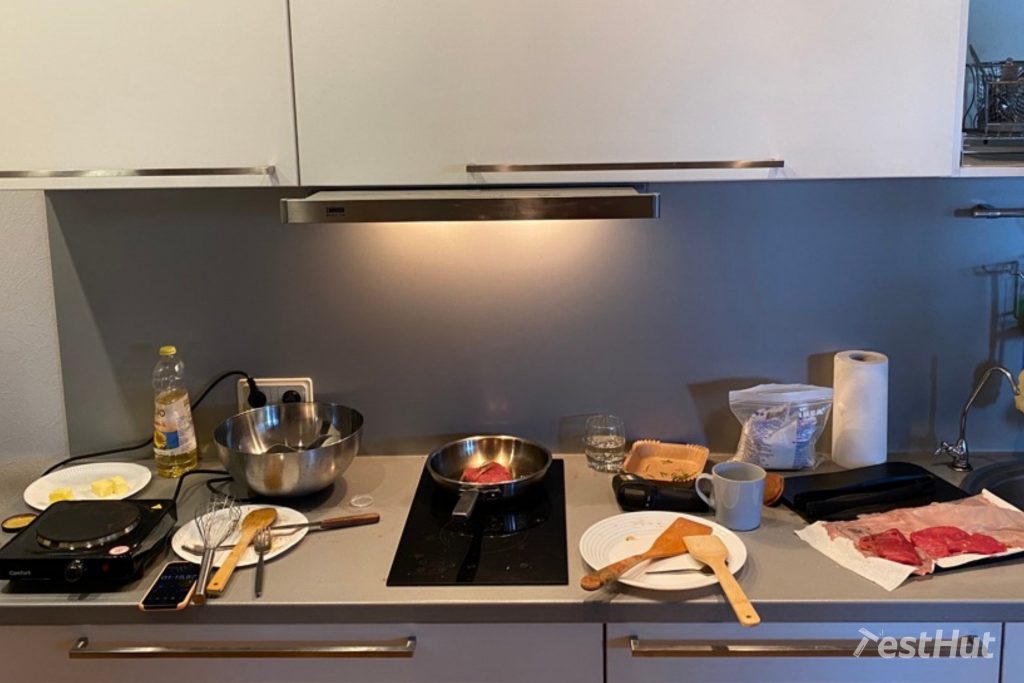
After every cooking session, we cleaned the pans and made notes about how easy they were to clean and care for. We examined the various interior and exterior surfaces for stains. After a month of testing, we used Barkeeper’s Friend and lots of elbow grease to see how hard each pan was to bring back to its original shine.
Stainless pans are generally very versatile, but we prepared various dishes from seared steaks and sauces to vegetable stir-fries and deep fried chicken to see how pans worked with different amounts of food testing both volume and surface area. We flipped foods with a flick of a wrist to see how well each one performed. We tested the pouring performance by seeing how easily tomato sauce flowed from each pan.
[videopack id=”2522″]https://www.testhut.com/uk/wp-content/uploads/sites/9/2021/12/Stainless_Steel_pans_sauce-1.mp4[/videopack]Finally, we scored the overall design of the pan including its aesthetic appeal and how easy it is to store in the kitchen.
You can read more about our testing procedures here.
Steel pans overall scores table
Once we finished these tests, we compiled the data and then scored each pan accordingly using our frying pan criteria. Each criteria was weighted based on importance:
- Cooking Performance (40%): How well this pan prepared food. This is the most important feature of any frying pan.
- Durability (20%): How well we think the pan will survive over time. We think that it is important to know that you are getting a quality product that will last.
- Ease of Use (15%): How easy it is to use. We tested the handle comfort and safety along with utensil use and other features to see how easy each pan was to use.
- Cleaning and Maintenance (15%): How hard it is to clean and maintain the pan. After each session, cleaning the pan takes time and energy.
- Versatility (5%): How the design of this pan allows it to be used for multiple cooking tasks. We weighed this lower because you can buy pans in different shapes and sizes for specific purposes.
- Design (5%): How the pan looks and how easy it is to store.
| Frying pan | OVERALL SCORE (100%) | Cooking performance (40%) | Durability (20%) | Ease of use (15%) | Cleaning and maintenance (15%) | Versatility (5%) | Design (5%) |
|---|---|---|---|---|---|---|---|
| Fissler Crispy Steelux Premium Pan 24 cm | 4.1 | 4.1 | 5.0 | 4.4 | 3.0 | 4.3 | 3.6 |
| Demeyere Industry 24 cm | 4.0 | 3.5 | 5.0 | 4.1 | 3.5 | 4.6 | 4.4 |
| Made In 10” Fry Pan | 3.9 | 3.5 | 5.0 | 4.3 | 3.0 | 3.8 | 4.8 |
| Lagostina Tempra 26 cm | 3.9 | 3.8 | 4.5 | 3.7 | 3.5 | 4.3 | 3.1 |
| Ikea Sensuell 24 cm | 3.5 | 3.3 | 4.0 | 3.9 | 3.0 | 3.9 | 4.0 |
Table notes:
Overall score: This is a compilation of all the categories and all these pans performed well. The only pan that scored below average was the Ikea Sensuell.
Cooking performance: Most of these pans performed well in food preparation. The Fissler scored the highest because we found that everything we prepared turned out good and foods released nicely from the surface. We did have more problems with the Ikea Sensuell than other pans in our tests when it came to heat evenness and steadiness.
Durability: While stainless pans are mostly indestructible, the Lagostina and Sensuell had plastic added to the handles that made them less durable than the other pans we tested.
Ease of use: These pans were all relatively well-balanced and easy to use. All the testers agreed that the Fissler was the easiest to use because of its shape, balance, and even heating. We found that the sharp angles and overall size of the Lagostina made it less enjoyable to cook with than the other pans in our test.
Cleaning and maintenance: These pans all took scrubbing and soaking to clean out after messy meals. Pans with lower scores took extra cleaning like the Fissler with its sharp angles on the handle or the Made In with its internal rivets that took some extra attention.
Versatility: Overall, stainless are the most versatile pans. With its deep sides, high capacity, and rounded corners, we found the Demeyere was a great pan for many different styles of cooking from searing to sautéing. We found that the Made In is a more purpose-built frying pan that does not accommodate all dishes because of its small surface area and shallow depth. The Sensuell is also a smaller pan that was not very versatile.
Design: We preferred the clad pans with clean lines and no distracting elements. The lowest score was given to the Lagostina with its industrial look and plastic handle.
Stainless steel pan buying guide
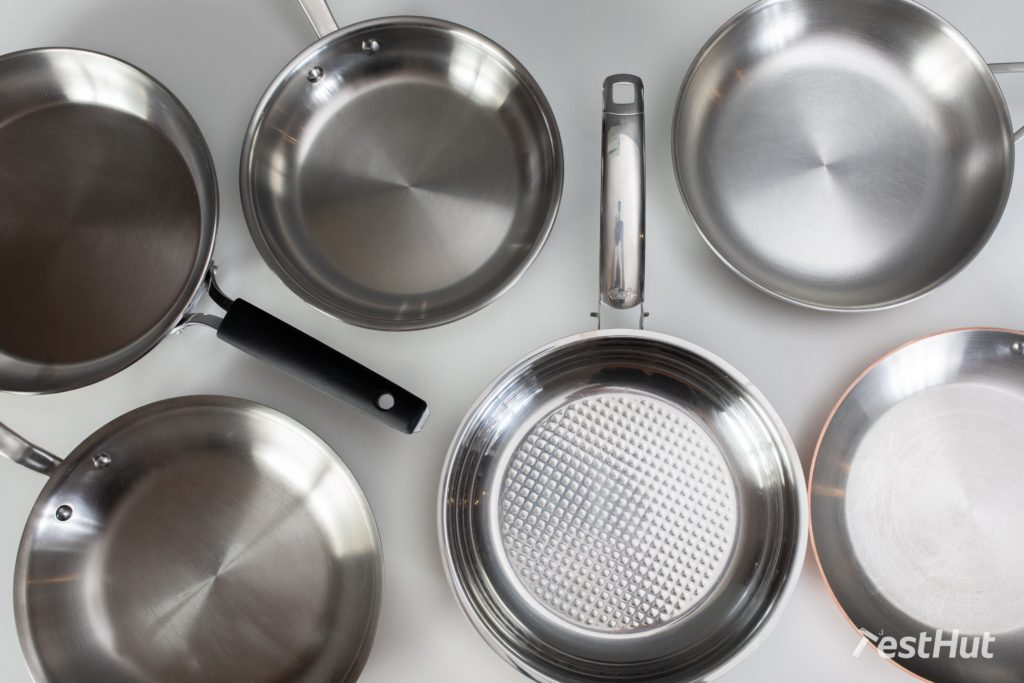
When you set out to buy a stainless steel pan, you will have lots of options. These are some things to consider before you make your choice.
Quality of the steel
The first thing when deciding to buy a stainless steel pan is to make sure that the pan is made of quality stainless steel which will be listed as 18/10 or 18/8 steel. The 18 stands for 18% chrome which is what makes the steel stainless, and the second number is the percentage of nickel added to the alloy. Nickel is expensive, so cheaper pans will skimp on this and these pans do not have the same heating qualities as higher-end steel pans. They are also less shiny and harder to keep clean.
The bottom of the pan may be made of a different type of steel to make it work with induction, usually 18/0 or 430.
Disc or clad?
Stainless steel is not a very good conductor of heat, so early on, cookware makers realized that they had to do something to make the pans heat better. One solution was to bond a disc to the bottom with more responsive metals like aluminium or copper inside. The other solution came later and this was to create a sandwich of metals clad together to give the whole pan uniform heat distribution.
Disc
Disc pans have a thick disc bonded to the bottom to distribute heat evenly to the base of the pan. In our tests, we found that these pans heated more evenly initially than clad pans, and they were easier to work with giving us consistent cooking results.
However, the disc only heats the bottom of the pan, so the sides of the pan may be a different temperature. You also need to make sure that the heat source is only under the bottom of the disc. On gas stoves with high flame, it may wrap around the pan causing heating issues.
Finally, poorly built disc pans can separate and the disc may not be quality hindering performance.
Clad
Clad pans are the same thickness from lip to base and there is no visible disc attached to the bottom. This creates a very responsive pan that heats up quickly and performs well.
Clad pans also come in varying degrees of quality and number of plies. 3-ply pans are the minimum with stainless, aluminium or copper, and stainless. But we have seen 5-ply and even 7-ply pans. More plans will equal more weight and higher cost, but this does not necessarily mean better cooking performance.
Generally you can get more pan for less money with a disc pan since these pans are easier to make, but professionals and pan connoisseurs swear by clad pans.
Handles
With stainless pans, you generally have two types of handles: rivets or welds. The other consideration is whether you want some sort of silicone or plastic coating on the handle.
Rivets
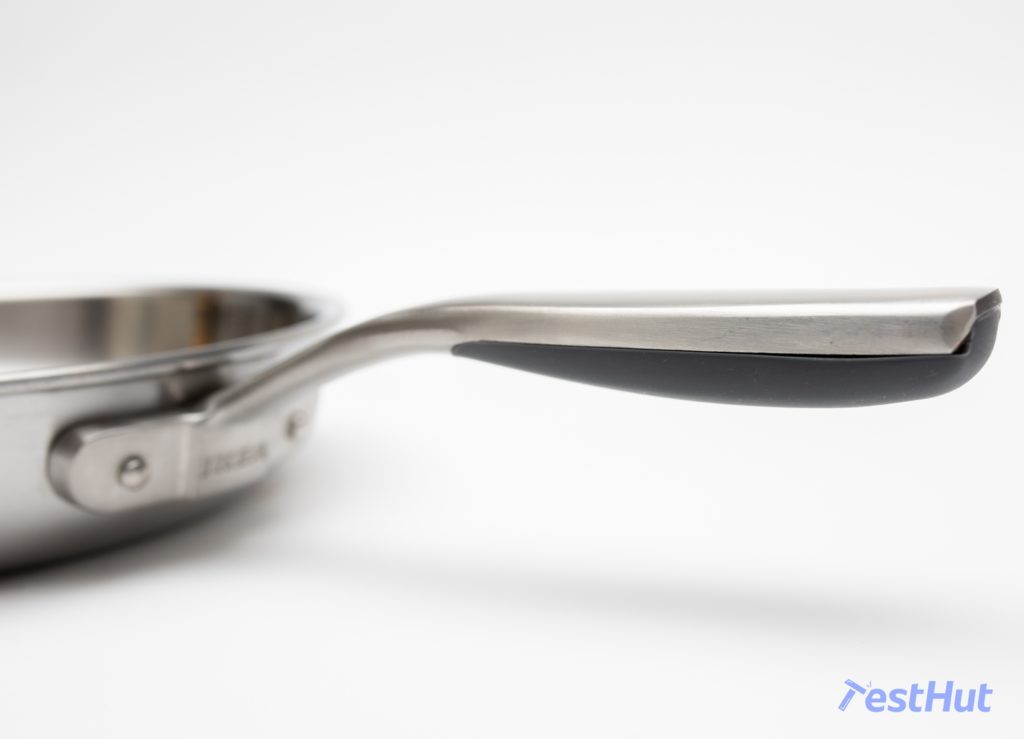
Handles attached with rivets use small holes in the body of the pan to force rivets through that are then sealed and bonded to the pan. You can see the rounded tops of the rivets inside these pans.
Rivets are very strong and durable, but they do leave these heads inside the pan that can collect grime and be difficult to clean over time.
Welds
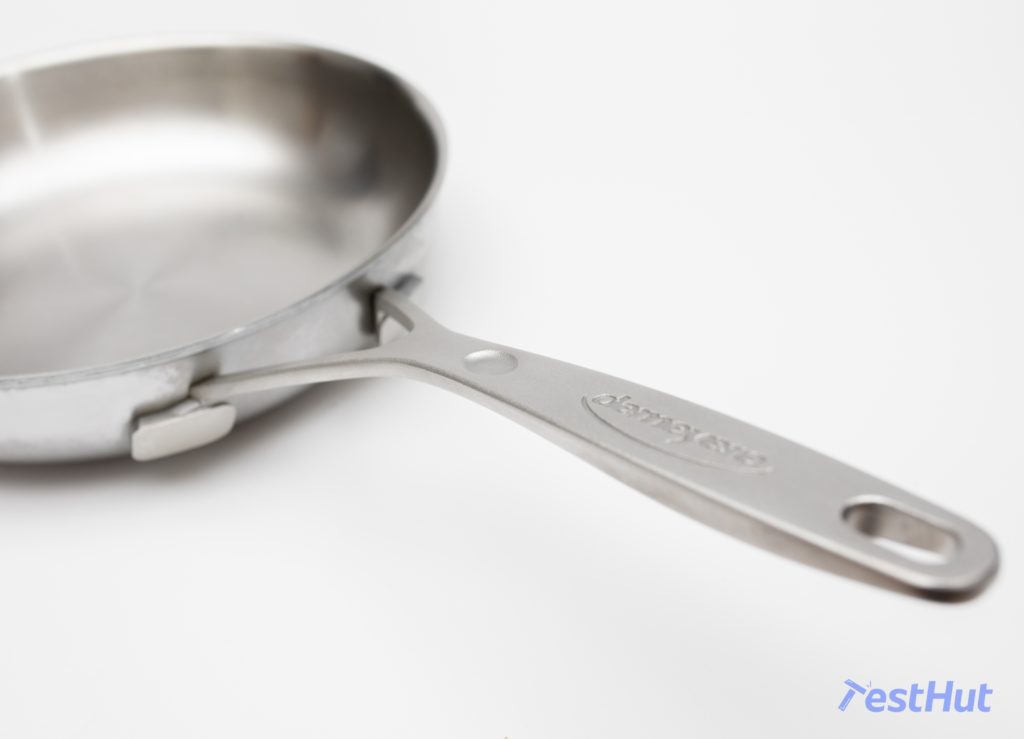
Other pans have handles welded directly to the outside of the pan leaving no interior rivets. Some think that rivets are automatically more durable, but this isn’t true. A well-made welded handle can be just as strong as a riveted handle.
The difference comes if these handles do fail. With rivets, you can see that they are coming loose and the pan gives you some warning. But with welds, if they break, they will just snap and it could lead to a disastrous kitchen mess.
We are confident that quality pans will have durable handle connections, and in our tests, all of these handles were very durable.
Handle coatings
We like the look, feel, and most of all durability of an all metal pan with a solid metal handle, but these can get warm and may be less comfortable to grip than other types of handles. Some pans come with silicone or plastic coatings to make them stay cool and be more comfortable.
The trade-off is that eventually the plastic or silicone will fail and you will have to figure out a way to repair it or live with a broken handle. If we are buying a stainless steel pan for life, we would like the handle to last as long as the pan.
Conclusion
When it comes to choosing quality cookware, the manufacturer’s reputation carries a lot of weight. Some of these companies have been in business for hundreds of years, and there is a reason for that. They have been producing quality products for a long time and built up a solid reputation. Researching the company can give you a good idea of the quality of their products.
or We think that stainless steel pans are an excellent option for just about any chef. They do have a bit of a learning curve, but once you get the hang of heating the pan first then adding oil and finally the food, the process becomes simple and the results will surprise you.
